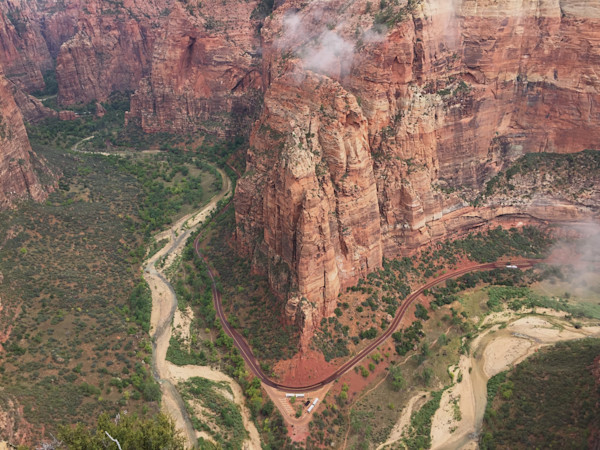
Frolic in Utah’s All Weather Playground
Snowy, sunny and in-betweeny. You might say we’re a state for all seasons.
The Four Seasons. Great name for a band, a concerto, a hotel, a landscaping business — and the weather in Utah. Yep, we have full blown spring, summer, fall and winter, and our temperatures run the gamut to prove it. January can get below freezing, while August may feel as if you stepped into an oven. But the best part? You can plan your vacation here based on whatever you want to do: hike, snow ski, bike, water ski, snowshoe … you get the idea.
Climate
As a desert, Utah’s climate is considered semi-arid. Basically, we don’t believe in doing muggy — it wreaks havoc on the hairdo. So when we say the temperature is 85 degrees Fahrenheit, it feels like it. The lack of humidity keeps the sky a clear, intense blue, particularly in the higher elevations. We think it’s worth slathering on an extra layer of lotion and lip balm.
That doesn’t mean we don’t get precipitation, just not a whole lot of it — about 15 inches of rain in the valleys per year. But we make up for it in winter; the average snowfall in Utah’s mountains is more than 450 inches (1,100 centimeters). We consider it The Greatest Snow on Earth.
Spring
Typically the most pleasant — and varied — weather in Utah happens in the spring, between April and early June. Temperatures warm up, but it’s not unusual to welcome a quick snowstorm as late as mid-May. In northern Utah, average temperatures range from the lower 60s to mid 80s, perfect for exploring the outdoors.
Southernmost Utah warms up quicker, and highs may reach the 70s as early as March. Pleasant weather and fewer crowds make this the ideal season to visit our five national parks. Overnight temps can quickly drop to the 40s in early spring, so bring a jacket for the chillier mornings and late evenings.
Summer
By late-May, we’re breaking out the swimsuits and sunscreen. Highs are in the 70s and only go up from there. July and August are the hottest months across the state.
Midsummer in Salt Lake City, expect average temps in the mid 90s. There are occasional thunderstorms, with impressive displays of lightning. But, the sun will come out tomorrow, and the day after, and the day after that.
In southern Utah, it’s just plain hot. As in, soak up enough heat to hold you over til next spring hot. June to August temps average 100 degrees, with many days going even higher; and, it only cools off to the mid 70s overnight. You’ll want to start any outdoor excursions early.
Even if you opted for the hotel with a swimming pool, plan to spend some time in non-chlorinated water while you’re here. Boating, fishing, white-water rafting, hikes to waterfalls — there is no shortage of outdoor activities. Summer is also popular for farmers markets and festivals: music, art, cars, food. You name it, we celebrate it.
Fall
September starts out warm as summer winds down, but Utah temperatures begin to drop rapidly; averages dip 10 degrees or more per month. By late October, average highs only reach the upper 50s. The nights are longer and cooler, so plan on a warm jacket when you head out to a local restaurant for dinner.
In southern Utah, it stays quite warm until November, when the average finally slips to the mid to lower 60s, and overnight lows around 40.
Winter
Does it snow in Utah? Oh yes it does! Piles and piles of the stuff. The valleys get more than 50 inches, while the mountains end up with more than 35 feet of it. When it’s clear, the air is crisp and the sky seems especially blue.
Because northern Utah is surrounded by mountains, we experience a weather phenomenon called “inversion” — cold air becomes trapped by higher warm air, resulting in mucky skies and chilly temperatures. This can occur between December and February following major snowstorms, and it can last for days. As a result, the pollution could be harmful for sensitive groups such as asthma sufferers. Often, though, you can get above it all if you head to higher elevations.
Utah’s temperatures diverge wildly across the state during winter. In northern Utah, it’s brisk; you’ll need a warm coat. Expect daytime highs near 40, but there are days when it can be much, much colder. But in St. George, the warmest spot in the state, the average high is in the 50s, and overnight lows only drop to the 30s. Snow is rare there, although it may rain occasionally.
Planning Your Visit
Like blowing fluffy plumes out of your mouth as you glide across a snow-covered meadow? See you in the winter. Would you rather slip on your sandals and twirl in a field of wildflowers? See you in the spring. Mountain biking? Golfing? Summer is calling. Hiking through gorgeous color? See you next fall.
When is the best time to visit Utah? Every season. Whatever you’re up for, Utah is your fair-weather friend. And cold weather. And everything-in-between weather. Check the local weather forecast as you make travel plans, then find activities on Utah.com to make the most of your time while you're here.
You May Also Like
View AllLake Powell: Whatever Floats Your Houseboat
Red-rock and roll with a Lake Powell houseboat rental.
An Unforgettable Utah Vacay? Lead the Way
Led by locals, these guided tours of national parks and other outdoor spaces are an authentic, affo...
Top 5 Sights in Bryce Canyon
Find the best hikes, and attractions in Bryce Canyon National Park. Check out these top five attract...

